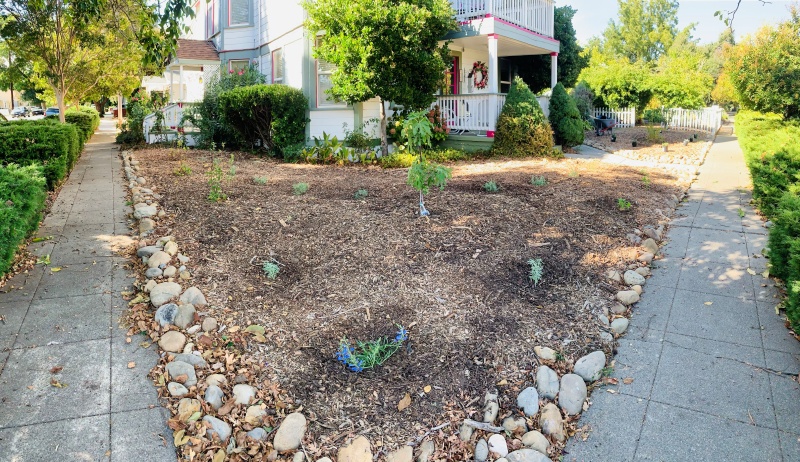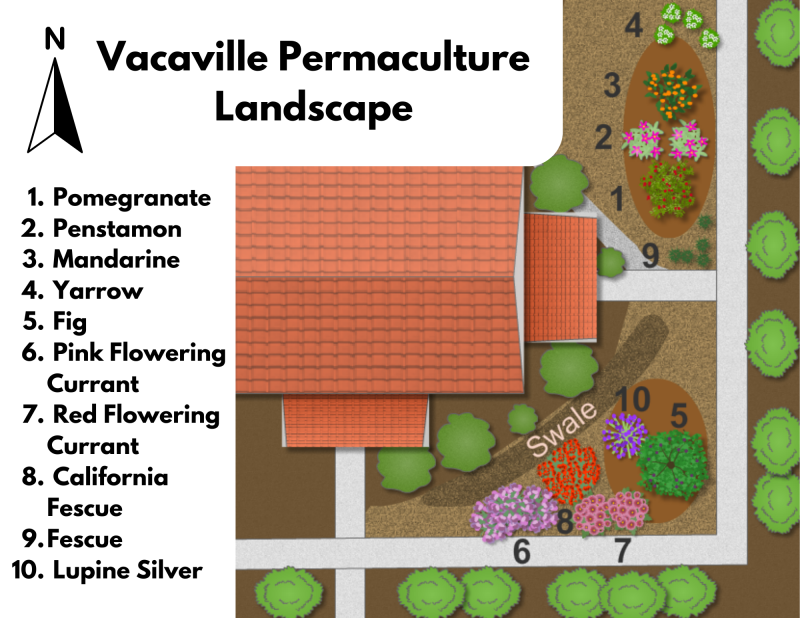Sustainable Landscaping Steps to Transform a Lawn and Life
By Alana Mirror, The Living Mirror Project
You may have met Alana at one of SuSol’s events and workshops, or seen some of her music videos or blog posts from those experiences. Here, she shares with us about her journey and talks about transforming her lawn to a sustainable landscape within the budget of the lawn conversion rebate she received. Learn more about that process during her free online talk on Jan. 23. You can register here.

Alana’s finished lawn-to-sustainable landscape project
Over the last year, I single-handedly transformed my entire front lawn into a native plant habitat and edible garden — all for less than $1,000 out-of-pocket! With financial support from the Water-Efficient Landscape Rebate program from the Solano County Water Agency for converting a lawn to a waterwise landscape and educational support from Sustainable Solano, not only have I been able to save water, support the ecosystem, and grow my own food, but I’ve also grown a tremendous sense of purpose, empowerment and hope. My mental and physical health have never been better. My heart has never been fuller. Indeed, transforming my lawn has transformed my life.
This blog is an invitation for you to join me in the great joy of serving the Earth within the intimate comfort of our own homes. You don’t have to be an expert. You don’t have to go into debt. I’m here to prove that a thriving world is right at our fingertips.
But, before I dive into the story of how that came to be, I want to acknowledge you. If you’re reading this blog, there’s a few things that I already know about you:
- You care deeply about the Earth.
- You are bravely willing to take responsibility for your part in creating thriving communities.
- You still have hope for what’s to come.
With that in mind, I hope my story will nourish the seeds that you have already planted within your own heart. Whether you’ve already begun making changes to your home and lifestyle, or you’re brand new to sustainable living, this blog is your affirmation: We can make a big impact in our own backyards; anyone can do it; and it’s an absolute joy.
Let me take you back to a time when I wasn’t so optimistic: I was a junior in college when An Inconvenient Truth shook the world with its warning that if we don’t change our ways, the world as we know it will come to a tragic end. It was a rough way to enter adulthood, to say the least. So rough, in fact, that I tried to sweep it under the rug. I tried to keep it all at bay: “It’s far away,” I would say.
But when the drought began to dry up our state, and the fires began to rage, it became clear that the future had arrived. It’s been three years since the day that the sun didn’t rise (remember that smoke-filled, eerie orange morning, summer 2020?). Now, after years of debilitating depression and anxiety, I’m happy to say: I finally found some natural lighting.
It all started with a podcast I was listening to by Greg Sarris (chairman of the Federated Indians of Graton Rancheria) with Obi Kaufmann (author of the California Field Atlas). They were discussing different ways that folks can support indigenous people’s environmental efforts and one of the suggestions was to transform your yard. “Claiming a space as home means being responsible to it by doing things like taking out your lawn and learning indigenous plants,” Obi said.
A bell rang. Chills moved through my veins. I didn’t know how I’d do it, but I’d find a way. I’d turn my lawn into a sustainable landscape.
First I talked to my uncle who had recently transformed his yard to be drought-resistant. He told me about the Water-Efficient Landscape Rebate Program that offers a rebate of $1.50 per square foot up to $1,500 for sustainable yard transformations. But, he had hired a landscaper who charged him $25,000! I didn’t have that kind of money! I would have to find a way to do it myself.
This was a tall order! I didn’t know anything about landscaping at all! So, I started by volunteering with the Putah Creek Council, a local nonprofit that does habitat restoration and protection of our watershed. There I learned about native plants. Eventually I even did an internship with them. But how would I translate all that to home?
That’s when I found Sustainable Solano, whose backyard program teaches folks how to incorporate elements of habitat restoration in their own backyards! By volunteering with Sustainable Solano, I started to learn the basics of the transformation:
- taking out your lawn with sheet mulching
- permaculture principles of design
- sustainable gardening
- and harvesting and storing rainwater in the ground!
In talking to one of the program managers, Nicole Newell, about my intention to transform my yard as close to the budget of the rebate program as possible, I expressed an interest in paving the path for others to be able to do the same. Being environmental stewards in our homes is something that should be accessible to everyone! In that spirit, she and I collaborated with sustainable designer Joshua Burman Thayer of Native Sun Designs to create a design template that any Solano County resident can use as a starting point for their own yard transformation.

Designer: Joshua Burman Thayer, Native Sun Designs
It felt like a miracle! Prior to this project, I had hidden my black-thumb and was embarrassed to try to grow herbs in pots! Now I was sharing surplus veggies!
The benefits went far beyond what I had expected: the garden was a magnet for all kinds of goodness: Neighbors would stop and chat. Lonely meals were supplemented by the satisfaction of knowing that I played a part in growing something so delicious. Plus, the wisdom of the Earth and the peace of the garden ended up being a tremendous companion while processing the grief of having recently lost my grandmother.
There was a hole being filled that I hadn’t known needed filling: For the first time in my life, I found my belonging. Hands in the soil, I reclaimed my place in the ecosystem.
And the more I learned, the more my hope grew! Did you know that 26% of greenhouse gases come from growing and transporting food? 70% of freshwater is used for food production? 50% of habitable land is used for agriculture? 78% of nutrient-overloaded water pollution (called eutrophication) is from farms?
Just imagine how the world would heal if we could grow, at a minimum, our own veggies!
It wasn’t long ago that most people had kitchen gardens right outside their front door. Before the mid-1800s, home gardens and wild food cultivation were a staple of human survival. Though gardens became more of a leisure activity as lawns took center stage and folks started moving into urban areas for manufacturing jobs, during World War II, “victory gardens” made a major comeback to fight food shortages, producing 40% of American produce in 1943. That means that there’s still people living today who remember what it was like to make a mass effort to grow our own food in a short period of time. If our grandparents could do it, so can we.
With 40,000 acres of land being used for lawns (that’s about half the total acreage of all the national parks), just imagine how our world would change if we simply made the switch from water-hungry and pesticide-prone green blankets to native flowers, trees, fruits and veggies?
With just a little help from each other, it’s all within reach. That’s why I’m here.
You can read my blog where I wrote original songs and told stories about how the process of installing the garden helped me to not only serve the Earth, but to make peace within me at The Living Mirror Project.
Then join me on Jan. 23 for Sustainable Yard Transformation on a Budget, a free online class with Sustainable Solano. I’ll share more of the nuts and bolts of what I learned in my journey of transforming my lawn, and how you can grow joy and hope with home sustainability. You can register here.

